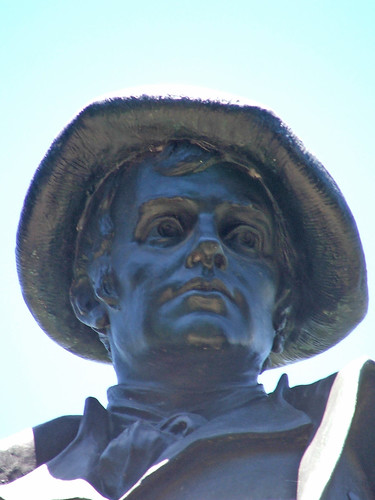
I have written here previously about the statue of Robert Burns by Frederick Pomeroy in the Sydney Domain. Now, thanks to the wonders of the Internet I have discovered some more of its history. A short time after the statue was erected, Edward Goodwillie published his book The World's Memorials of Robert Burns in Detroit, Michigan. Lacking the Internet he gathered information about the statues and memorials from correspondents all over the world. His information about the statue in Sydney came from Mr. James Muir, a much-traveled, well-read Scot, one of the greatest students of Burns in Australia, if not in the world.
The text of his book and a pdf file version are available.
SYDNEY, NEW SOUTH WALES. Sydney, the oldest city in Australia and the Capital of what is now the State of New South Wales, has an elaborate memorial to Burns in its picturesque "Domain." The desire amongst the leal-hearted Scots of this beautiful city of hills and harbors to erect a memorial of some kind to the Bard of Scotia, existed for many years as an aspiration, and slowly but surely gathered strength towards practical realization. A few enthusiastic spirits banded themselves together in the early nineties, pledging each other to eat haggis on the 25th of January and to collect funds for a Burns statue during the remainder of the year. They designated themselves the "Burns Monument Committee," and for some years went joyously on their way. Finally, however, they determined to take more aggressive steps, and in 1898 they appealed to the Highland Society of New South Wales to take up the work. The latter cordially assented and accepted the collected funds, amounting to some fifty-five pounds, as a nucleus, at the same time shouldering the responsibility to erect a Burns statue.
...
In furtherance of the cause, Mr. Muir published an excellently written brochure, entitled "An Australian Appreciation of Robert Burns' which did much to forward the movement for the statue. This committee was backed up financially by the Caledonian Societies in New South Wales and also by thousands of private subscribers of varying amounts ; and as a result of their incessant labors they were able to unveil, on the 30th January, 1905, to the gaze of an admiring multitude, the beautiful statue in the "Domain."
And here is the origin of the statue:
The Sydney "Domain" memorial of Burns certainly takes first rank amongst those of its class. In general lines the figure follows the Paisley statue, but in some minor details the sculptor, Mr. F. W. Pomeroy, of London, agreeably adopted some suggested alterations made by the Sydney committee.
Mr. Goodwillie's book discusses the Paisley statue as well:
It is the work of a London sculptor, Mr. F. W. Pomeroy, whose design was chosen on the recommendation of Sir Thomas Brock, the Royal Academician, sculptor of the National Memorial to Queen Victoria in London, and knighted by King George on the occasion of its dedication, May, 1911. The poet is represented clad in the costume of the period tail coat, knee breeches and broad Kilmarnock bonnet leaning on an old Scottish plough. In his right hand, which rests on the plough, is a pencil, and in his left a note book. The attitude is contemplative. The statue proper is of bronze, ten feet high, and with the pedestal twenty-two feet. The pedestal is of gray granite, and has one panel of aluminum in front, representing "Tam o' Shanter" crossing the Brig o' Doon chased by the witches.
Elsewhere, we learn that Frederick Pomeroy, who had already contributed some sculpted panels to a building in Paisley, won a competition with his design of the Burns sculpture. This is the Paisley version:
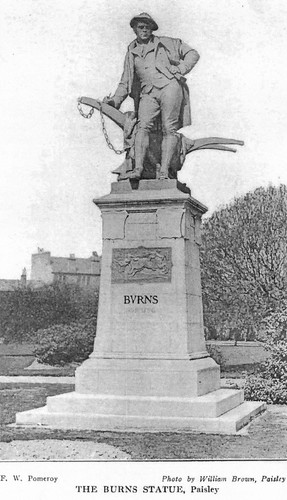
Apart from the chain attached to the plough, which does not appear in the Sydney version, I have not yet found the minor details in which the sculptor agreeably adopted some suggested alterations made by the Sydney committee; although the pedestal, (the design of Mr. J. W. Manson of Sydney, who acted as honorary architect, is of granite and is somewhat different from the commonplace style so widely adopted for similar statues, and surely harmonizes with the strong, rough, natural genius of the poet ) lacks the Tam o' Shanter aluminium panel attached to the Paisley statue.
Edward Pinnington, a contemporary art critic said of the Paisley statue:
"F. W. Pomeroy wisely abandoned precedent and convention without roughly defying prevailing views of physical likeness. Burns looks every inch a man; somewhat ponderous, perhaps, across the loins for agility, but muscular, broad and strong. An ample plaid lends the burly peasant all the grace he needs, and, falling over the plough at the back, partly hides a thistle. The emblem is not obtruded, because the sculptor wishes the poet to be seen as the Poet of Humanity first, and as that of Scotland afterwards. Mr. Pomeroy tried for something original and he succeeded. In his Burns he has portrayed the thinker and poet of boundless potentiality, without neglecting the toil-bent worker or the athlete. Capable as a work of art, the statue is endowed with a life-like vigor and picturesque grace which ensure its acceptance."
I hadn't thought to look at the back of the Domain statue before reading this, but if you doubted plaid could be represented in bronze - there it is:
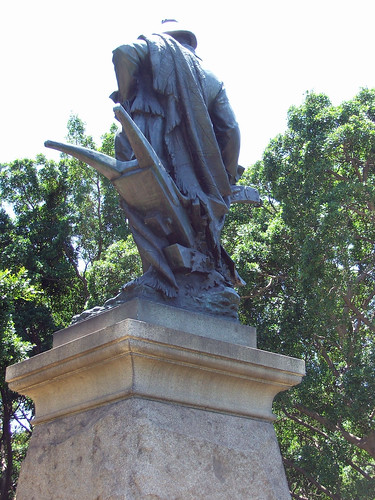
And the thistle too :
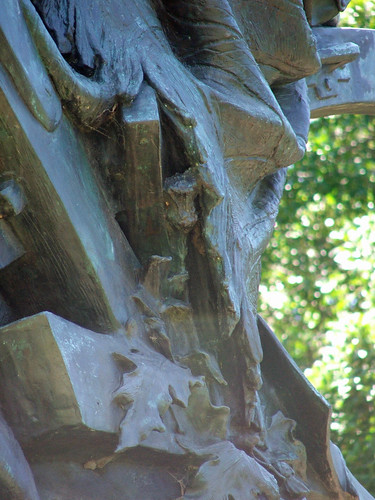
New Zealand has one as well - in 1921, a replica of the Paisley statue was unveiled in Auckland.
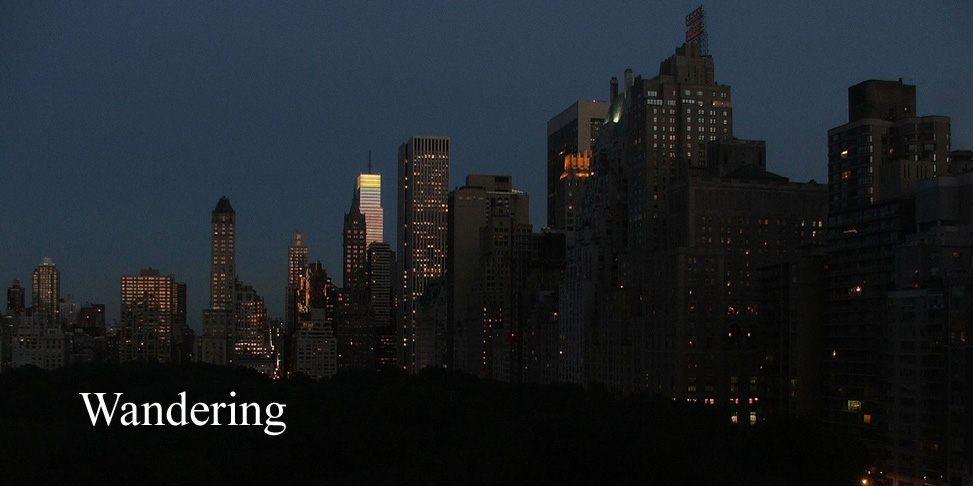




No comments:
Post a Comment